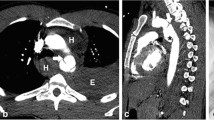Abstract
Rib series rarely add information to the posteroanterior (PA) film for the diagnosis of rib fractures. In this investigation, we evaluated the utility of rib X-rays using turnaround time (TAT), radiation exposure, and cost-efficiency as the key parameters. This investigation was conducted from January 2008 to December 2012. We included patients who had rib series performed for suspected rib fractures. TAT for patients was calculated from the time exam was ordered by the emergency department (ED) physician/staff to time the report was finalized by the attending radiologist. Effective radiation dose for rib series was calculated as a summation of radiation dose from the standard rib series images for each patient. Cost-efficiency was determined based on the number of interventions that took place as a result of a complicated study. Our investigation consisted of 422 patients, 208 females aged (57 ± 20.8) and 214 males aged (48 ± 17.3). A total of 74(17.5 %) abnormal findings were noted, out of which only 1(0.23 %) underwent management change. The mean turnaround time for patients undergoing rib series had a value of 133.5 (±129.8) min as opposed to a single chest PA of 61.8(± 64) min. Average effective radiation dose for a rib series was 0.105 (±0.04) mSv, whereas average effective radiation dose of a single chest PA was 0.02 mSv. Dedicated rib series has a low-yield diagnostic value as it pertains to management change. The overall impact on patient care based on our findings is small when compared to the risks associated with prolonged TAT, repeated exposure to radiation, and extensive medical costs.




Similar content being viewed by others
References
National Hospital Ambulatory Medical Care Survey (2010) Emergency Department Summary. http://www.cdc.gov/nchs/fastats/ervisits.htm. Accessed 9 Sept 2013
Recinos G, Inaba K, Dubose J, Barmparas G, Teixeira PG, Talving P et al (2009) Epidemiology of sternal fractures. Am Surg 75:401–404
Southall AC, Harris VV (1999) Patient ED turnaround times: a comparative review. Am J Emerg Med 17:151–153
Griffith JF, Rainer TH, Ching AS, Law KL, Cocks RA, Metreweli C (1999) Sonography compared with radiography in revealing acute rib fracture. AJR Am J Roentgenol 173:1603–1609
Sears BW, Luchette FA, Esposito TJ, Dickson EL, Grant M, Santaniello JM et al (2005) Old fashion clinical judgment in the era of protocols: is mandatory chest X-ray necessary in injured patients? J Trauma 59:324–330, discussion 330–322
Bansidhar BJ, Lagares-Garcia JA, Miller SL (2002) Clinical rib fractures: are follow-up chest X-rays a waste of resources? Am Surg 68:449–453
American College of Radiology ACR appropriateness criteria. http://www.guideline.gov/annotated-bibliographies/index.aspx
Berrington de González A, Darby S (2004) Risk of cancer from diagnostic X-rays: estimates for the UK and 14 other countries. Lancet 363:345–351
Kleinerman RA (2006) Cancer risks following diagnostic and therapeutic radiation exposure in children. Pediatr Radiol 36(Suppl 2):121–125
Johnson TV, Master VA (2012) Sensitive biomarkers of cancer recurrence and metastasis: inexpensive tools to cut costs and reduce radiation exposure among cancer patients. Mol Diagn Ther 16:13–14
Kattan KR (1978) Trauma of the bony thorax. Semin Roentgenol 13:69–77
Ruger JP, Richter CJ, Spitznagel EL, Lewis LM (2004) Analysis of costs, length of stay, and utilization of emergency department services by frequent users: implications for health policy. Acad Emerg Med 11:1311–1317
Shah KH, Slovis BH, Runde D, Godbout B, Newman DH, Lee J (2013) Radiation exposure among patients with the highest CT scan utilization in the emergency department. Emerg Radiol. doi:10.1007/s10140-013-1142-8
Anand P, Kunnumakkara AB, Kunnumakara AB, Sundaram C, Harikumar KB, Tharakan ST et al (2008) Cancer is a preventable disease that requires major lifestyle changes. Pharm Res 25:2097–2116
Conflict of interest
The authors declare that they have no conflict of interest.
Disclaimer
There was no commercial funding for the study. The authors have full control over all the data. The paper will not be published elsewhere in any language without the consent of the copyright owners.
Author information
Authors and Affiliations
Corresponding author
Additional information
Faisal Khosa is the American Roentgen Ray Society scholar (2013–2015)
Rights and permissions
About this article
Cite this article
Shuaib, W., Vijayasarathi, A., Tiwana, M.H. et al. The diagnostic utility of rib series in assessing rib fractures. Emerg Radiol 21, 159–164 (2014). https://doi.org/10.1007/s10140-013-1177-x
Received:
Accepted:
Published:
Issue Date:
DOI: https://doi.org/10.1007/s10140-013-1177-x




